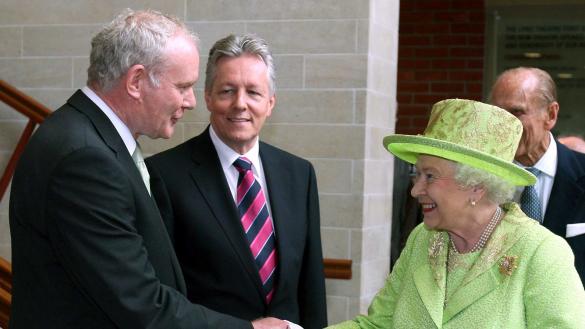Author: Mark Woods, 11 September 2022
The history of the island of Ireland and mainland Britain makes very painful reading, of which the Troubles of the 1960s to the 1990s were the latest instalment. More than 3,500 people died, approximately 60 per cent of whom were killed by Republican paramilitaries intent on creating a united Ireland following the creation of Northern Ireland and the Irish Free State in 1922.
To speak of and model reconciliation when so much blood had been shed would have been hard for anyone, and the conflict touched Queen Elizabeth personally.
Her willingness to pursue reconciliation had its roots not only in her deep commitment to the service of her country, but also in her deep Christian faith. In 1987 she used her Christmas message to pay tribute to Gordon Wilson, who publicly forgave those who murdered his daughter in a bomb at Enniskillen Cenotaph on Remembrance Sunday: ‘His strength, and that of his wife, and the courage of their daughter, came from their Christian conviction,’ she said. ‘All of us will echo their prayer that out of the personal tragedies of Enniskillen may come a reconciliation between the communities.’
When she made her state visit to the Republic of Ireland in 2011 at the invitation of President Mary McAleese she was the first reigning monarch of the United Kingdom to visit since her grandfather in 1911.
The occasion was deeply symbolic. Republican violence had touched her own family with the murder in 1979 of her cousin Lord Louis Mountbatten, killed on his boat in Co Sligo with two teenagers, Nicholas Knatchbull and Paul Maxwell, and the 83- year-old Doreen, Dowager Lady Brabourn; two years later, during a visit to Shetland, Republican paramilitaries had tried to kill the Queen.

Queen Elizabeth shakes hands with Northern Ireland deputy first minister Martin McGuinness, 2012. Reuters/Paul Faith
But it was the shared history of the two nations that gave the event such significance. In her address at the Castle – constrained as she was by the politics of the occasion – she spoke words of healing, saying: ‘It is a sad and regrettable reality that through history our islands have experienced more than their fair share of heartache, turbulence and loss.
‘These events have touched us all, many of us personally, and are a painful legacy. We can never forget those who have died or been injured or their families.’
And, she said, ‘With the benefit of historical hindsight we can all see things which we would wish had been done differently or not at all.’
She went on to speak of the need for peace and understanding, and for the rebuilding of friendship: ‘we have much to do together to build a future for all our grandchildren; the kind of future our grandparents could only dream of’.
As she said during her Christmas broadcast that year, ‘Forgiveness lies at the heart of the Christian faith. It can heal broken families, it can restore friendships and it can reconcile divided communities. It is in forgiveness that we feel the power of God’s love.’
And the following year saw another profoundly significant gesture. Visiting Northern Ireland, Queen Elizabeth met and shook hands with Martin McGuinness, the former IRA commander whose organisation would once have regarded her death at their hands as a triumph. McGuinness, then Northern Ireland's Deputy First Minister, is reported to have told her that their meeting was a ‘powerful signal than peace-building requires leadership’. Forgiveness and reconciliation can be very costly, requiring great reserves of spiritual strength. The Queen found those reserves in her Christian faith, and in the example of Jesus.
Share this: